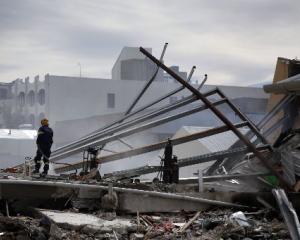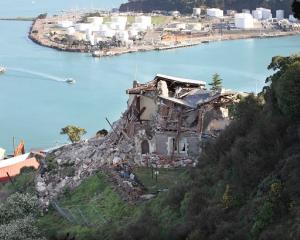Fire chiefs failed to cope with the February 22 earthquake response, according to a scathing report out today which criticised them for being disorganised, out of the loop, and failing to support their firefighters who were battling to save lives.
The New Zealand Fire Service has released an independent review of its management's response in the first 12 hours of the Christchurch disaster, which claimed 185 lives.
The review, carried out by West Yorkshire Fire & Rescue Service chief executive and Chief Fire Officer Simon Pilling, found that the scale of event would have "stretched any fire service in the world".
But while frontline firefighters are praised in the report for their heroic and brave actions in the chaotic hours after the deadly jolt at 12.51pm, the executive officers could have been "better organised, integrated and supportive" of operational crews and incident commanders.
A decision to withdraw and "largely prevent" some local Christchurch crews from carrying out life-saving operations within the city less than 24 hours into the incident provided the "blue-touch paper" for operational crews to "react adversely towards management".
"The lack of clarity of roles and ownership of critical references by executive officers, together with a lack of overt leadership and management in support of incident commanders operating in the field, are viewed by the review, as impediments to achieving best practice during the critical phase of response," Mr Pilling wrote.
"Executive officers hold positions of responsibility and accountability in the service, managerially and operationally. The type, complexity and level of the overall event and individual sites should have attracted a higher presence and involvement of these officers."
He said the fire service also failed to learn lessons from the earlier magnitude-7.1 earthquake of September 4, 2010, which sparked the earthquake sequence and triggered thousands of aftershocks.
The report concluded that the lack of pre-planning and preparedness following the September event contributed to the "overall inefficiency and ineffectiveness" of management.
Incident support arrangements during the first 12 hours were provided in "an ad hoc fashion" and with a "piecemeal approach" and were carried out in the main by operational staff during the initial throes of the event.
Management failed to take advantage of a number of opportunities to review command structures and options on the day, the report concluded.
Despite the magnitude of the disaster, and the problems it created, the report said it was still reasonable to expect "at least a single officer" to take charge of setting up the Fire Emergency Operations Centre and to become responsible for a single incident management team supporting the key sites each run by operations commanders, and to work with other emergency services and agencies.
One of the most emotive areas Mr Pilling found during his investigations, was a "legacy" of the prolonged dispute between the Fire Service Commission, management, operational staff and the Professional Firefighters Union (PFU) in the 1990s over restructuring and funding reduction, and the introduction of Community Safety Teams.
Mr Pilling said those longstanding workforce relationship difficulties had provided a backdrop to the emergency event and were likely to have contributed to the behaviour and choices made by a number of executive officers involved.
One fire official told him: "You need to understand that the organisation changed in the most dramatic fashion imaginable back in the 1990s. Structural revision together with a zealous transition to all things prevention rather than response, that undoubtedly brought about significant improvements in public safety, but came at a cost and we are managing that legacy today."
The review made a number of key recommendations which were put into five strategic themes: Incident Command and Control, Emergency Services Interoperability, Leadership and Management, Integrated Risk Management, and Industrial/Employee Relations.
Mr Pilling also warned that if a similar earthquake should hit Wellington, the impact would "probably be far greater with many times more people losing their lives", which highlighted the importance for each New Zealand region to introduce a systematic plan for executive officers and operational commanders to follow and implement.
"The scale of such an event in Wellington, for example, is almost unimaginable, however, that is exactly what the service must plan for in order to be better prepared and organised," Mr Pilling said.
Chief executive and National Commander Paul Baxter said lessons would be learnt from the findings, especially over criticism of management.
"I know that everyone who lost friends and family in the earthquake wants us, and other agencies, to extract all the learning possible from the emergency so that we are better prepared for any future disaster."
He also accepted that the review's conclusions raised tensions between Christchurch managers and staff.
"I am addressing these issues and have made significant progress in recent months," Mr Baxter said.
The president of the Southern Branch of the New Zealand Professional Firefighters Union, Denis Fitzmaurice, welcomed the review,which addressed concerns raised by the union after February 22.
"The union is extremely proud of its members, their professionalism, dedication to duty and bravery during this seminal event in our city's history.
"We acknowledge the changes in personnel at senior management level in Christchurch and the wider region."






